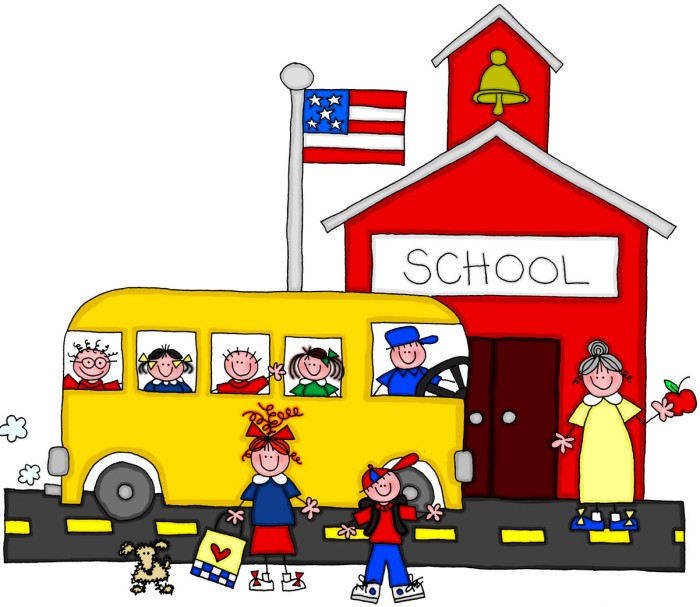
Schools are such important institutions in today’s society. Have you ever wondered how and why our educational system came into being? The One-room Schoolhouse by Paul Rocheleau does an excellent job of chronicling the origin of public education to present day.
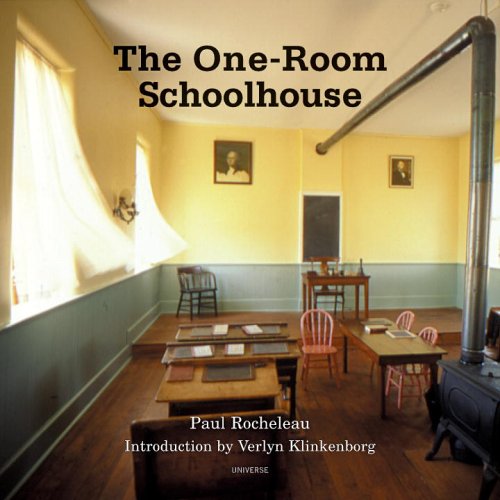
Before there were colonies in America, public education was virtually nonexistant. Only the elite and members of the clergy were formally educated. Most common people were illiterate. A few commoners learned to read if they were taught by the elite or learned by being an apprentice but this was more the exception than the rule.
American colonies were more or less settled by groups of people seeking religious freedom. With the invention of the printing press privately owned Bibles were more common. The Quakers in particular wanted their children to be able to read. Schools were established primarily to teach people how to read their Bibles. The primary textbook of any school was the Bible. Every school day was also started with prayer.
One room schoolhouses were built. They were usually situated near a field and built in areas where children lived. Early educators made school buildings convenient to where the children were, whereas today schools are built for the convenience of the school districts and children are bussed to the schools.
The one room school houses were built out of a variety of building materials, usually whatever was available locally. Sometimes there were embellishments to the basic rectangular design of the schools and as colonies became more prosperous they would be built with a bit more flair since schools often pulled multiple duties as schools, churches, voting places, and social halls. The earliest schools that were framed buildings were not usually painted in the beginning since paint was very expensive and not readily available. Again, when colonies became more prosperous it was reflected in their schools. Paint began to be a part of the buildings as well as other embellishments. The financial health of any given community was often reflected in the details of their school(s).
Some schools were built from wood / trees:


Some builders used mud and built schools in an adobe style:

Some were brick:

Some were made of stone:

Sometimes different structural designs were tried with more progressive ideas such as this octagonal one room school:

The idea behind the octagonal design was the progressive thinking at the time of believing if the student desks were placed around the walls, the teacher could maintain a close proximity to students by being in the center of the room and more readily accessible to all of the students. It didn’t take long to figure out that placing students behind the teacher’s back was not a good idea. Many a teacher who tried this method found him or her self the object of mischief. This design didn’t last too long.
Particularly in the colder states, “cloak rooms” began to be added to one room school houses. A cloak room was just an inside wall. It’s primary purpose was to keep out as much cold air as possible when the door (or doors) were opened. However, the back of this wall was used to store coats, jackets, lunches, and free time items used for recess periods or lunch breaks.



The cloak room also had the advantage of allowing the teacher to see exactly who was coming in to the school and who was leaving. A popular arrangement was to place the teacher’s desk in front of the cloak room wall. In this way the teacher knew the comings and goings of students and his or her back was protected. In the next image, note the doors on both ends of the cloak room wall. Boys and girls entered through separate doors.
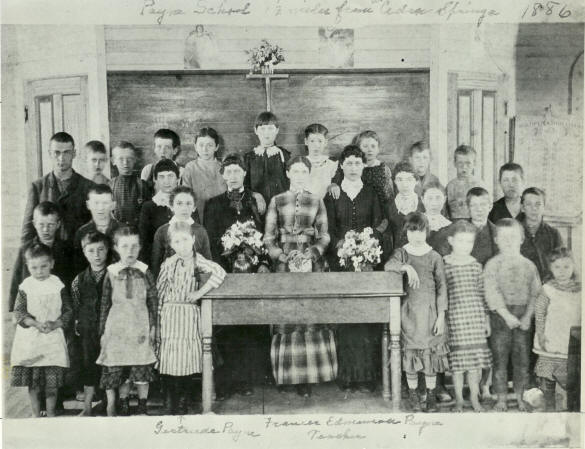
One room school houses in the US were in use roughly from the 1700’s to the present day. The majority of one room school houses finally closed their doors as schools in the mid to late 1940’s. Some of the one room schools had been updated with modern lights and electricity. As communities began to grow and the populations grew, sometimes the one room school houses were partitioned off into separate rooms and often there was more than one teacher. In those areas that were growing rapidly, sometimes second stories were added to the buildings. Eventually multi-room schools were built and began to resemble the schools we know today.
Those of us who went to elementary schools built circa the 1940’s or 1950’s will remember cloak room hallways attached to our classrooms:
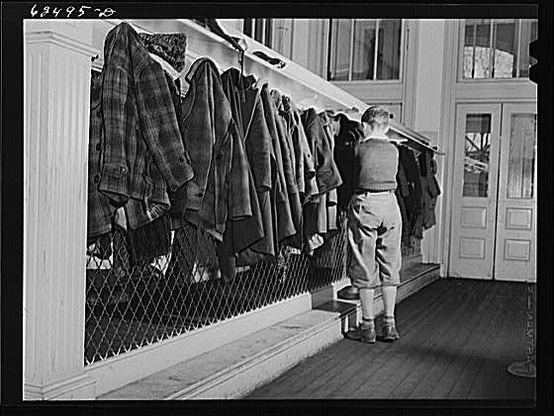
These “modern cloak rooms” were actually a small hallway with hooks on each side. Boys used hooks on one side and girls used the opposite wall of hooks. Just like their predecessors, these cloakrooms also stored lunch and items used at recess or lunch periods. These cloakrooms were not only practical, they were also a nostalgic nod to the past.
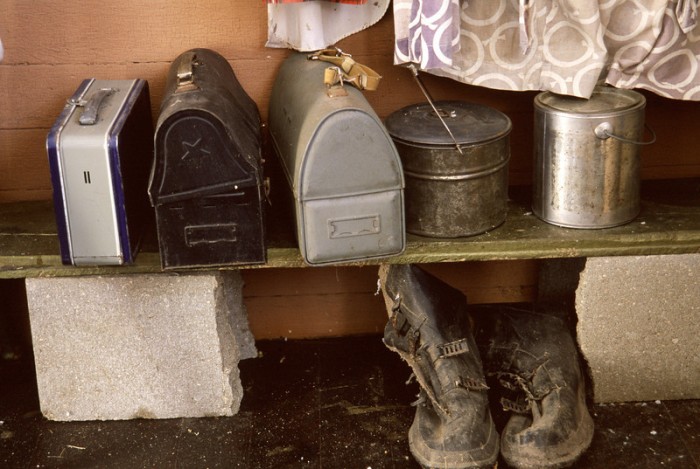
Quakers (New Englanders) weren’t the only people to influence schooling and education. There were other middle and southern colonies. Since like people seemed to settle mostly together, there were other ideas pertaining to education. In Europe, elite education had long been established. The elite from the southern colonies sent their children overseas to be educated “back home” in England. Of those children who remained to be educated in the south, their educational model was based on England’s schools. The middle colonies were comprised of quite a diverse melting pot of people all seeking to pursue their own religious beliefs. The majority of these people became unified and learned to be tolerant of each other because they were primarily Protestants. Since the primary goal of the schools at this point was to teach people to read their Bibles, the educational system was eventually able to blend and meld towards common goals. There were some exceptions to this such as early groups of Jewish immigrants in Rhode Island and New York. In Maryland there was a Catholic settlement. However the majority of people in the New World labeled themselves as Protestant and the thirteen colonies considered themselves a “Protestant nation.”
Schools were segregated in the south. Black schools in the south were often run down structures, ill equipped with books and supplies. Often untrained teachers could only teach what they knew.

If blacks learned to read before there were black schools in the South, it was likely because a white person taught them. It was extremely dangerous in some southern states for a black person to be literate. Unfortunately there was a prevailing attitude of extreme white supremacy and an era of slavery. Plantation owners feared a slave rebellion if blacks were educated. After the abolition of slavery, black schools were allowed but were often extremely overcrowded.

These horrendous conditions were tolerated at first because southern blacks were grateful to have any educational opportunities at all. Some black educators were happy to have whites stay out of their curriculum. However, the black schools were still at the mercy of white overseers.
Not everyone agreed with these conditions, however, and both blacks and whites worked towards a more equal system of education. In 1954 the US Supreme Court ruled unanimously “that legally-sanctioned racial segregation in the public schools is a violation of the US Constitution’s promise of equal protection of the laws.” It was still several years until desegregation was fully enforced in all states. However, this ruling by the Supreme Court forever changed education in the US and was a major victory celebrated by many blacks and whites alike. Unfortunately not everyone was happy about this turn of events. The need to fight discrimination on many fronts–including education–eventually led to the Civil Rights Movement.
As the various settlements grew, education was becoming compulsory. Most settlements were required to have an elementary school which taught basic subjects of reading, writing, religion, and colonial law. Girls were educated in these subjects until the ages of 10-12. Girls then often received additional lessons in sewing, weaving and other home arts. (Today we can see a similar model in the Amish community where girls are usually educated to the 8th grade and then receive instruction in sewing and home arts.) Girls (usually from elite families who made sure to educate both their sons and their daughters) did have the option of going to a “Dame School.” Often this was a residential school taught by a widow. The widow would take in a number of children for a fee or something bartered and teach the girls fundamental skills. Wealthy families could hire private tutors to teach their children at home, while those families who were not wealthy may have made a contract called an apprenticeship. Under this agreement a child (almost always a boy) would be an apprentice for a specified period of time and learn a trade from a skilled craftsman.
For those who were exceptional students, the colonies provided “schools of higher learning.” In the earlier years of the colonies, these schools were almost always comprised of boys. These schools were free to the poor, but were funded through tax payer money and were sometimes called English free schools. Just like in Europe, these schools often taught their material in the original language. For instance if the original source was in Latin, the subject would be completely taught in Latin. The same was true of subjects (like the Bible) that were originally written in Hebrew or Greek. These schools were also called “Latin grammar schools.”
Around the mid 1700’s, people began to complain that the grammar schools were outdated and needed to be modernized. Many did not think that the classic approach to education was beneficial to colonial life. In 1749 Benjamin Franklin wanted to add content subjects such as business, technology, sciences, mathematics, and other subjects that would be more practical to colonial life. Franklin thought the content should be chosen according to the vocation that a given student wanted to pursue. Franklin was ahead of his time though and was considered too “secular” in his thinking so the grammar schools continued for some time teaching core concepts in foreign languages and teaching the Bible.
Eventually other core subjects were added in to the school curriculum and more opportunities opened up for girls and women in higher education. One of the reasons that women began to be better educated was the growing demand for more teachers. At that time, most teachers were female although there were some men involved in education. My Grandma, Amy Wolcott Cramer, taught school in a one room school house in Iowa.
Below is a picture of Prill School built in 1876 and located right here in Fulton County, Indiana (approximately 15 minutes away from the Fulton County Public Library):

Prill School has been preserved as a museum and sometimes local school children go there to learn about the past. I couldn’t find out for sure, but I believe this photo was taken just prior to the preservation work.

For those of you who like a ghost story, it is said that the Prill School area is haunted by a former teacher. In the picture above, a young woman plays the part of a school teacher named Sarah. To locals she is known as “Sister Sarah.” There are many Sister Sarah stories. Here is one from strangeusa.com:
Prill School is haunted by a woman named Sister Sarah. Some say if you go out there on the night of a full moon and you sit with your rearview mirror facing the tree in the yard, you will see her ghost next to or in the tree. Other people say that on a full moon if you leave a piece of paper with questions on it and come back the next day, there will be answers written on there to the questions that were asked. Sister Sarah was a teacher in the school when it was open. There are many stories to how and why she died and God knows which one is the truth. There are so many stories to if you go out there at night. [Sic]
This is but one of many stories. If you are interested in a few more stories, follow the link to Sister Sarah. Many local people still claim to have had bizarre experiences at Prill School including one of my coworkers. There are probably hundreds of Sister Sarah stories but not all Sister Sarah stories are related to Prill School. Some surround her home, grave, and area where she lived.
There are still many one room school houses in Indiana and indeed in the country; all of which are in various conditions of existence. I believe that some are still open and functioning as Amish schools. There are some one room schools in the US still operating as historical or specialized schools. Some of the old one room schools have been converted into private homes. Sadly many of these historical treasures sit in states of disrepair.

Other books I checked out but don’t have time to comment on:
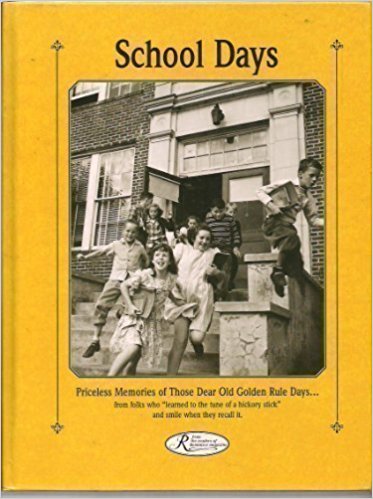


Have you ever participated in a one room school reenactment? Are there any one room schools in your area? If so, what are they being used for? Where you aware that US schools were started with the express purpose of teaching people to read the Bible?

This post reminded me of all the wonderful times I enjoyed at my elementary school. It wasn’t a one room schoolhouse, but, it was a wonderful school with amazing teachers.
LikeLiked by 1 person
I’m glad you have fond memories of school.
LikeLike
I saw a show called “You Live in What?” or something like that and people had renovated an old schoolhouse to live in as their home – it was very cool. Another great and informative post!
LikeLiked by 2 people
Thank you. Yes, I’ve seen pictures of old schools turned into homes. They are sort of the forerunners of “tiny houses.” One of my coworkers lives in a renovated church.
LikeLiked by 1 person
Very interesting. Great research!
LikeLiked by 1 person
Thank you.
LikeLike
Hi Jennifer!! Back from the dead, so to speak, to say hi!
I love all the pictures. I’ve read so many pioneer stories, sometimes I think I am living then! Except, I can do the dresses all the time! lol
Great article! I’m glad all the crime ones are long gone!
Merry Christmas!
LikeLiked by 1 person
Welcome back! I’ve been wondering where you were.
I love all the pictures too. In this post I think my favorite is the stone schoolhouse in the snow.
Yes, I do enjoy reading true crime, but I am actually glad not to have to be writing about it all of the time now.
Merry Christmas!
LikeLiked by 1 person
Thanks!! I missed you!
LikeLiked by 1 person
Ditto. I’ve been on your site a couple of times but it wouldn’t let me comment without filling out a lot of stuff.
LikeLike
We have remnants of 1 room school houses in the mountains in North Carolina. Great history has been preserved giving some details about the history back then.
Very interesting post to share. Thank you.
LikeLiked by 1 person
Yes, I find that sort of history fascinating.
LikeLiked by 1 person
Great post. When I was young, I remember seeing unused one-room schools up in Minnesota. Thanks for sharing the great pictures too. Merry Christmas
LikeLiked by 1 person
Thanks. When the weather is a bit nicer, I want to go out to Prill school.
I didn’t see this until after Christmas but thank you for the great wishes and I hope your Christmas was very merry as well!
LikeLiked by 1 person
Interesting post! I love those images you found. My grandmother went to a one room school house in the early 1920’s I believe. I know in my immediate area there is one school house that is just run down. It is on a plot of farm land and they just kind of leave it there.
One year in grade school we went on a trip and had to dress up in farm clothing. I can’t remember the name of the place, but they did the whole reenactment thing with us. We sat in the schoolhouse, dipped our own candles and a few other fun things.
LikeLiked by 1 person
Great memories you shared!
LikeLike
Really enjoyed seeing your local Prill School.
LikeLiked by 1 person
Thanks. I wish I could’ve arranged to go out there previously but it just wasn’t meant to be at that point in time.
LikeLike
well researched and very well illustrated and written.
LikeLiked by 1 person
Thank you.
LikeLike
Excellent article and I like your photos, too!
LikeLiked by 1 person
Thank you.
LikeLiked by 1 person